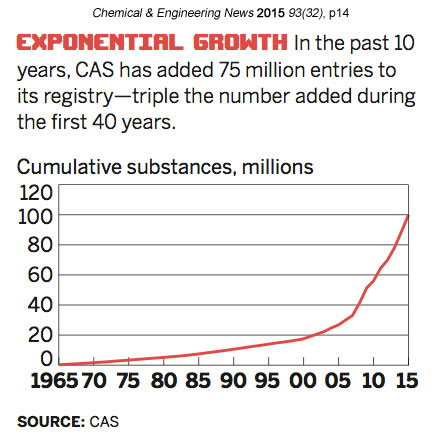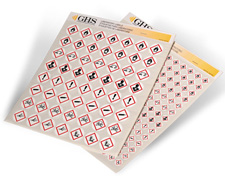



Find all of your laboratory and workplace safety supplies at Safety Emporium!
 Carcinoma |
 Glossary Index |
 Cataract |
| MSDS Topics |
Free Sites | FAQ's | Regulations | Glossary | Software | Suppliers |
| Books | Forum | Poll | Fun stuff | Quiz | Store | |
| Understand your MSDS with the MS-Demystifier | Search ALL our MSDS info | |||||
A CAS (Chemical Abstracts Service) Registry Number is a unique identifier that tells you, for example, that acetone and dimethyl ketone are actually the same substance. From a safety and inventory perspective, this is a terrific idea. As of 2022, there were 194,000,000 unique chemical substances indexed by CAS as well as 70,000,000 protein and nucleic acid sequences. In April 2021, CAS announced it had registered its 250 millionth unique chemical substance. See https://www.cas.org/about/faqs for more info.
The Chemical Abstracts Service, https://www.cas.org/, is a division of the American Chemical Society, https://www.acs.org/.
There has been an exponential growth in the number of substances indexed by CAS, with the number doubling between 2009 and 2015 as shown in this graph:

Key point: CAS numbers identify the chemical, but not its concentration or specific mixture. For example, hydrogen chloride (HCl) has the CAS number 7647-01-0. That CAS number will appear on containers of anhydrous hydrogen chloride, a 20% solution of HCl in water, and a 2.0 molar solution of HCl in diethyl ether.
The numbers you see on trucks on the highway are not CAS Numbers, but U.S. Department of Transportation (DOT) mandated UN/NA codes which are not necessarily specific to each chemical. Their aim is to assist emergency responders. To find out what's in that tanker truck, check out the interactive version of the Emergency Response Guidebook at https://wwwapps.tc.gc.ca/saf-sec-sur/3/erg-gmu/erg/ergmenu.aspx. Once you know what chemical it is, you can look up the SDS. You can order a printed copy of the guidebook by following the appropriate link on https://phmsa.dot.gov/hazmat/library/erg. Great fun for the kids on those long trips!

Get your GHS-compliant labels and signs from Safety Emporium.
Prior to the implementation of the GHS (Globally Harmonized System of Classification and Labeling of Chemicals) in the US, the CAS number was not required information on Safety Data Sheets. Effective June 1, 2015 OSHA required that manufacturers and importers ship SDS's in the 16-part standardized GHS format that includes CAS numbers as a required element in Section 3 (Composition/information on ingredients) of the SDS. Distributors had until Dec 1, 2015 to use up their existing inventory with the old MSDS and labels.
What that means for your workplace is that you should regularly check your SDS collection to see if you have the latest version of each sheet. If yours is not up to date it's time to look for or request a new one. But see Can I throw away old or outdated SDS's? before deciding what to do with the old one.
Note: A 2020 study in Environ. Sci. Technol. found that approximately 120,000 of the 350,000+ chemicals currently used in commercial products were too poorly described to link to a CAS number or their chemical identities were withheld as a trade secret. Therefore, the availability of this information on some SDS's may sometimes be limited.
Filing chemicals by CAS number is one way to avoid the problem of finding an SDS by name ("did I file that under dichloromethane or methylene chloride??"). Even if you have a computerized system you should include a field for CAS number because chemical names are often misspelled by non-chemists and spelling checkers do not handle technical terms very well. For more on chemical naming, see the IUPAC entry.
Remember: CAS numbers uniquely identify a chemical, but not necessarily the manufacturer or concentration. Other identifying systems are discussed in their own SDS FAQ entry.

Your chemical reactions can be run safely and effectively with US-made clamps and other laboratory accessories from Safety Emporium.
See also: DOT, EINECS number, NSN and NIIN's, UN/NA numbers.
Additional definitions from Google and OneLook.
Entry last updated: Sunday, May 22, 2022. This page is copyright 2000-2025 by ILPI. Unauthorized duplication or posting on other web sites is expressly prohibited. Send suggestions, comments, and new entry desires (include the URL if applicable) to us by email.
Disclaimer: The information contained herein is believed to be true and accurate, however ILPI makes no guarantees concerning the veracity of any statement. Use of any information on this page is at the reader's own risk. ILPI strongly encourages the reader to consult the appropriate local, state and federal agencies concerning the matters discussed herein.